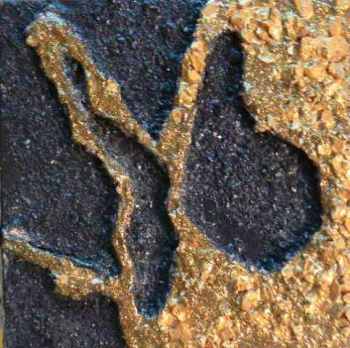Signatures
of Care
This series began in the Spring of 2004
and were fueled, in part,
by the writings of
physicist John C. Polkinghorne
1989 AD
astrophysicist Paul Davies 1995 AD
molecular biologist Michael
J. Denton 1988 AD
molecular biologist Michael
Behe 1996 AD
and Hebraic songwriter David 1000 BC.

Signature of Care. xc 6"
h x 6" w mixed media on foam core 2004
Machines
" Molecular
machines
haul cargo from one place in the cell
to another along "highways"
made of other molecules, while
still others act as cables,
ropes, and pulleys to hold the cell
in shape, Machines turn
cellular switches on and off,
sometimes killing the cell
or
causing it to grow. Solar-powered
machines capture the energy
of photons and store it in
chemicals. Electrical
machines allow current to flow
through nerves.
Manufacturing machines build other
molecular machines, as well
as themselves. Cells swim
using machines, copy
themselves
with machinery, ingest
food with machinery. In
short,
highly sophisticated molecular
machines control every
cellular process. Thus the details
of life are finely
calibrated, and the machinery of life
enormously complex."
zig
zig. Michael Behe
" Darwin's Black Box," pp. 4, 5,
1996
"
In
ancient times all of
biology was a black box, because
no one understood on even
the broadest level how living
things worked. The ancients
who gaped at a plant or
animal and wondered just how
the thing worked were in
the presence of unfathomable
technology. They were
truly in the dark."
zig
zig. Michael Behe,
"Darwin's Black Box," p.7
+++++
"
Neurons are
the basic structural components of
the brain. A neuron is an
individual cell,
specialized by
architectural features that enable fast
changes of voltage
across its membrane as well as voltage
changes in
neighboring neurons. Brains are assemblies
of just
such cells, and while an
individual neuron does not see or
reason or remember, brains
regularly do. How do you get
from ion movement across
cell membranes to memory or
perception in brains? What
is the nature of neuron-neuron
connectivity and
interactivity? What makes a clump of
neurons a nervous system?"
zig
zig. Patricia S.
Churchland and Terrance J. Sejnowski
" The Computational
Brain," MIT Press, 1992, p, 1 Introduction
+++++
" In
every direction the biochemist gazes, as he journeys
through this weird molecular
labyrinth, he sees devices and
appliances reminiscent of
our own twentieth-century world
of advanced technology. In
the atomic fabric of life we have
found a reflection of our
own technology."
zig
zig. Michael J. Denton
" Evolution: A Theory in Crisis,"
p. 340, 1985